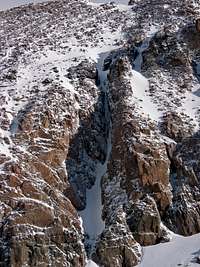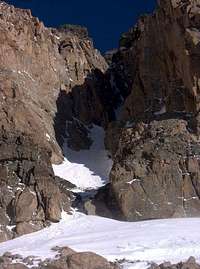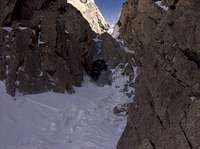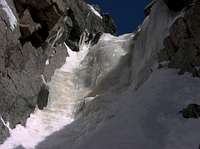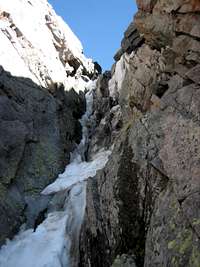-
 22953 Hits
22953 Hits
-
 85.87% Score
85.87% Score
-
 21 Votes
21 Votes
|
|
Route |
|---|---|
|
|
40.26014°N / 105.60544°W |
|
|
Trad Climbing, Ice Climbing, Mixed |
|
|
Spring, Fall, Winter |
|
|
Most of a day |
|
|
5.6 (YDS) |
|
|
WI2+ (M1) |
|
|
2 |
|
|
II |
|
|
Overview
Martha is the name given to the main couloir which runs down the south face of Mount Lady Washington. Clocking in at around 750', this route will challenge you with a variety of snow, ice and rock conditions. Unlike some of its nearby north-facing companions (e.g.: Flying Dutchman, Dreamweaver), Martha will tend to get more sun and thus potentially have more ice on her during the colder winter months. Conversely, she may lose viability sooner than the aforementioned routes due to this aspect.
Getting There
Start from the main Long's Peak trailhead off of Hwy 7. Follow the trail up and above tree-line until you reach Chasm junction; this is where the main trail heads right up and around the eastern flanks of Mt Lady Washington to Granite Pass. You will want to follow the Chasm Lake trail to the left; basically head towards the magnificent view of Long's Peak's diamond face. The trail will take you to the Chasm Lake cabin at which point head up and right above the cabin to find Chasm Lake proper. Circle around to the right (or if frozen, cross over the lake) looking up at the south face of Mt Lady Washington until the route comes into view. Find a spot to gear up and get your crampons on.*Warning*
In the winter and early spring months, the route from Chasm Junction to the cabin passes across a snow apron which can become very prone to avalanches. Use caution and wise judgment before crossing this area after freshly loaded with wind-blown snow.
Route Description
Some descriptions of the route rate it as having 5 pitches of climbing. Depending on conditions and/or your comfort level on moderate to steep snow as well as low angle ice steps, you may find that you will only need to rope up for 2 pitches.
Pitch 1
That said the first part of the climb rises up from Chasm Lake on a moderately angled snow apron (not unlike her brothers the Flying Dutchman or Lamb's Slide) and approaches a constriction area which may contain snow, ice covered rocks, or bare rock. The rock steps are fairly small can be surmounted fairly quickly depending on conditions and experience level.
Pitch 2
Once past the initial constriction, you find yourself back on a wide snow apron that slowly steepens as you climb. It will also start to narrow and slightly jog to the right. This might be considered the second pitch of the climb and tends to end as the route narrows drastically at another constriction.
Pitch 3
Depending on conditions the next pitch could be all snow, but it narrows down to around 3 feet in width and upwards of 50 degrees in steepness. It could also be more alpine ice and/or water ice. If you need to set up the belay for this pitch off to the left before the constriction. As you climb up this section it gets steeper and leads to a large rock rib that pretty much splits the couloir in two. You'll probably encounter a little mixed move across frozen rock on the left side. Stay on the left side of the rib but right at the bottom of it to find a ledge for setting up the belay for pitch 4.
Pitch 4
For the pitch 4, you could go straight up and on the left side of the rock rib or, hop over the rock rib (it is easier than it looks) and continue up on low angle rock which may or may not be covered in snow/ice. There will be rock protection along the right side. There are many options to proceed upwards with, but eventually you will see the crux pitch ahead of you. Look for anchor placements on the right, but well below the ice pillars.
Pitch 5
You've now made it to the fun challenge of the climb. Depending on conditions this could go at a WI2+ or M1. If it is fully in, you should be able to tackle it straight on and to the right up nice ice. If not, there is rock protection to the left (look for a fixed nut) and you will be required to work on some mixed stemming between rock and questionable ice/snow. If you do work the left side you can squeeze yourself into an off-width jam with an undercling while looking for a nut or cam placement on top of the rock bulge. Once protected you'll need to swing out around the rock to the right and up. All in all you are looking at about 25 feet of work here.
That's it for the tough stuff. You'll now be standing on steep angled snow (be careful in late season conditions). Kick-step your way up about 30 more feet and look up and left. You should find a very nice crack system for an anchor, as well as chockstone to sling for backup. It is very comfortable to work with an autoblock sitting on a rock ledge to bring up the second.
Once you are both here, if you are comfortable you can pack up the gear. Trudge up another 40' or so and head left to work yourself over to the descent to the Camel Gulley. Or, continue straight up on varied snow and rock to the top of Mt Lady Washington and descend via the East Slopes
Essential Gear
You should do fine with around 3 ice screws (both 10cm and 13cm); full set of stoppers; cams from 0.5 to #2 (or tri-cams from .5 to 3.5 with doubles in the 0.5 and 1); about a dozen draws with plenty of double-length slings.Crux comparisons
Having had the opportunity to climb this route twice within 3 weeks of each I got to see the crux in two wildly different versions. The first time on 27 April 2008 it was a meager, barely attached ice flow that forced some fun mixed stemming (image on the left). Just barely considered "in". The second time on 17 May 2008 it was much fatter (image on the right). Probably could've been fatter; but in the early morning the ice was very strong and took picks well. The May photo was taken one week after Eli Helmuth stated on his site that the ice was as fat as he'd ever seen it. The photo he took of it that day (7 May 2008, you can see the photo here.) actually looked less "in" than what we had on 17 May 2008. Also the ice section on pitch 4 below the crux was a lot better as well. I thought it would be nice for everyone to be able to see a few of the wildly varying conditions you can get on this route.Added a final photo of the season by Mark Cushman showing the meltout of the crux in mid-June. This is what it looks like when no ice is present. The ice is very welcome and necessary as the climb went to a 5.6-ish variation with very loose and dangerous rock.


